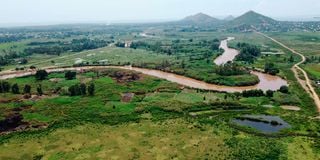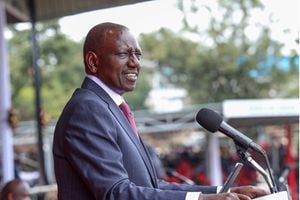Preparing for El Nino rains amid flooding fears

River Nzoia, whose source is Cherangany Hills, wreaks havoc downstream whenever it rains.
What you need to know:
- The Kenya Red Cross reported that an estimated 800,000 people were affected by the El Nino rains in Kenya in 1997-1998.
- This includes those who were displaced, suffered property damage or faced other consequences of the heavy rainfall and flooding.
Residents of Budalangi in Busia County live in constant fear of flooding. The El Nino prediction only exacerbates problems for the communities residing there.
For years, this area has been a hotspot for flooding, leaving thousands of residents homeless. In 2020, River Nzoia overflowed its banks, rendering many homeless and destroying property. Those who wished to salvage anything had no choice but to use boats as their sole means of transport.
Sharon Akinyi, a mother of four from Sibanje Village has lived in a makeshift home since 2020 when it last rained heavily.
"The last time it rained heavily, all our properties were swept away. Well-wishers gave us this tent. During the day it’s very hot and at night it’s extremely cold. I live here with my four children. We have heard that El Nino is coming; we are worried but we cannot move because we have nowhere to go,” she says.
The government has embarked on various mitigation measures including public awareness, relocating some people from hotspots and mapping out flood-prone areas ahead of El Nino rains, which are expected to continue until January 2024.
Busia Governor Paul Otwoma said they are taking a multi-agency approach in their El Nino preparedness and mitigation measures. He said they have mapped out areas that are likely to be flood-prone, identified mitigation measures and put the necessary resources in place. “We are committed to ensuring the safety of our people during the rainy season,” he affirmed.
Governor Otuoma stressed the importance of collaboration between different institutions and government departments in formulating a comprehensive response plan. “Cooperation with organisations like the Red Cross guarantees a coordinated effort in dealing with any emergencies that may arise. Furthermore, the county has allocated resources to support these collaborative endeavours,” he said.
The construction of dams in highland areas has been identified as a key initiative to reduce flood risks and support agricultural activities. “The dams will play a vital role in ensuring sustainable farming practices in Busia County.”
The governor urged residents to stay informed about weather forecasts and upcoming events. “It is crucial for individuals to exercise caution and avoid unnecessary risks during this period”. He also urged locals to report any signs of landslides or areas that require intervention from authorities.
Samuel Magoba, 70, has witnessed every season of flooding in Budalangi and he now wants the government to strengthen existing dykes as a precautionary measure.
Gibson Kisomanyiro, a resident of Kapkiringo Village in Mt Elgon, said his home was split into pieces during a mudslide in 2020.
Dennis Manyoror, another resident of Mt Elgon, said, “The rains started in the evening, and it rained heavily. People were going to the market and other places. Since we don't have bridges to cross over to the next village, they had to dare the waters or wait for the raging waters to calm before they crossed over.' Bungoma County Special Programmes Director Caren Wanyonyi said they have mapped out hotspots across the county and are starting public awareness campaigns to ensure that residents are well-informed about the risks and how to protect themselves during El Niño.
The Kenya Red Cross reported that an estimated 800,000 people were affected by the El Nino rains in Kenya in 1997-1998. This includes those who were displaced, suffered property damage or faced other consequences of the heavy rainfall and flooding.
The El Niño is not just happening in Africa. An Anticipated Humanitarian Impact Report 2023 published by ACAPS in July this year shows that the El Niño will have severe impacts in Central America (dry conditions), northern South America (dry conditions), East Africa (both dry and wet conditions), and East Asia and the Pacific (dry conditions).




